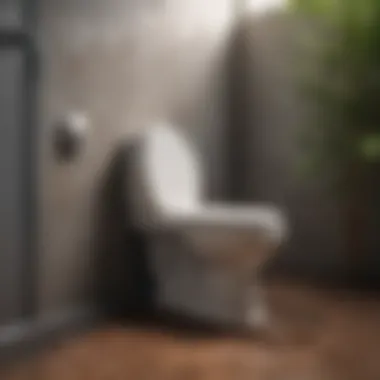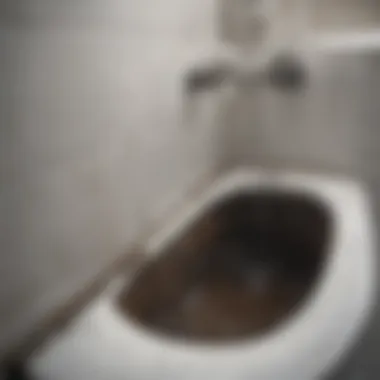Understanding Outside Toilet Drain Overflow Solutions


Intro
Understanding the intricacies around outside toilet drains is essential for effective property management. Overflowing drains can lead to both sanitary concerns and depreciated property values. When left unaddressed, such issues can escalate, causing significant stress for homeowners and property managers alike.
In this discussion, we will delve into the causes of overflow, explore maintenance strategies, and examine the implications of neglecting these systems. Readers, particularly homeowners and property management professionals, will find valuable insights that emphasize the necessity of addressing outdoor toilet drainage problems promptly.
Causes of Outside Toilet Drain Overflow
Outdoor toilet drains can overflow due to a number of factors. One primary cause is blockage from debris, roots, or even accumulated waste. This blockage restricts water flow, leading to backups and overflow. Another cause could be improper installation of the drainage system. Inadequate slope or incorrect piping can contribute significantly to drainage issues. Lastly, heavy rainfall can overwhelm drains, pushing systems beyond their capacity.
By understanding these causes, homeowners can take preventive action before overflowing occurs.
Maintenance Considerations
Regular maintenance is critical for preventing overflow issues. Homeowners should periodically inspect their outdoor toilet drains for signs of deterioration. Here are key maintenance tips:
- Keep the areas around the drains clear from debris.
- Trim tree roots that may invade the drainage system.
- Ensure proper grading around the toilet drains to facilitate water flow.
- Schedule professional inspections periodically to evaluate system integrity.
By implementing these maintenance practices, homeowners can reduce the likelihood of future overflow.
Solutions to Restore Proper Functionality
When overflow does occur, addressing it quickly is vital. Immediate solutions include:
- Clearing Blockages: Using a plumbing snake or hydro jet to dislodge blockages.
- Repairing or Replacing Pipes: If pipes are cracked or broken, you may need to replace them to restore proper function.
- Installing Backflow Valves: Consider adding these devices to prevent future overflow incidents.
These solutions can significantly mitigate potential damage and ensure efficient drainage.
Impact on Property Value and Sanitation
Ignoring overflow issues can lead to serious consequences. The sanitation risks posed by overflowing toilet drains can affect the health of residents and lead to additional costs for cleanup and repair. Moreover, potential buyers often overlook properties with a history of drainage problems, impacting property value.
It's essential to maintain a clean and functioning outdoor toilet drain to uphold both health standards and property value.
Epilogue
In summary, understanding the causes, maintenance needs, and solutions related to outside toilet drain overflowing is crucial for homeowners and property managers. By keeping a close eye on drainage systems and addressing issues proactively, individuals can maintain property value while ensuring a hygienic environment. The interplay between effective management of outdoor toilets and overall property maintenance cannot be overstated. Addressing these challenges promptly is the key to preserving both health and value.
Prelude to Outside Toilet Drain Issues
Outside toilet drains are a crucial part of any property's plumbing system. Understanding these drains and their potential issues allows homeowners and property managers to maintain functionality, which is essential in preventing severe problems down the road. This section aims to lay the groundwork for the following discussions on drainage issues, which will delve into causes, assessments, and solutions.
Defining Outside Toilets and Drainage Systems
Outside toilets, commonly known as outdoor lavatories, often serve properties without direct connections to municipal sewer systems. These toilets may rely on septic tanks or other drainage solutions. Understanding the anatomy of an outside toilet involves recognizing various components including pipes, traps, and vent systems that work together to facilitate waste management.
Drainage systems, therefore, encompass a series of interconnected pipes and filters designed to ensure that waste and excess water are directed safely away from the structure. Proper functioning of these systems is paramount for hygiene and property health. Many systems utilize gravity; so design elements need to be well thought out. Improper grading can lead to significant issues such as backflow or overflow.
Importance of Proper Drainage Management
Effective drainage management significantly influences both residential sanitation and local environmental health. Overflowing drains present multiple concerns, including but not limited to unpleasant odors, unsightliness, and health risks from pathogen exposure. Properly managing an outside toilet’s drainage system minimizes risks and ensures compliance with local sanitation regulations.
Regular maintenance can help identify potential issues before they escalate. Homeowners should prioritize consistent inspections of their outside toilets and associated drainage systems. Keeping drains clear helps in mitigating issues related to blockages, which is one of the major causes of drain overflow.
Common Causes of Overflowing Outside Toilets
Understanding the common causes of overflowing outside toilets is fundamental for effective management of such issues. Overflowing can lead to not only unpleasant experiences but also significant health risks and environmental damage. By identifying the core reasons behind this malfunction, homeowners and property managers can adopt a proactive approach to prevent future occurrences. This section outlines some primary contributors to outside toilet overflow. Addressing these causes ensures longevity and reliability of drainage systems.
Blockages in the Drainage System
One of the leading contributors to overflowing outside toilets is blockages in the drainage system. These blockages can result from various factors, such as the accumulation of debris, roots from nearby trees, or even foreign objects accidentally entering the system. When water cannot flow freely due to these impediments, pressure builds up, leading to overflow.


Homeowners should regularly inspect their drainage systems for any visible signs of blockage. Utilizing a simple inspection tool or a camera can help assess the condition inside the pipes. Clearing minor blockages can often prevent major issues. In more severe cases, professional help may be required to restore proper flow.
Improper Installation of Toilet and Drain
Improper installation of outside toilets and their drainage systems can cause significant problems. If the toilet is not installed at the correct angle or height, it may lead to ineffective drainage. Additionally, if pipes are incorrectly connected or sealed, water may not flow as intended, which creates a risk of overflow.
To avoid this, it is crucial to ensure that installations are done by certified professionals. This guarantees compliance with local building codes and standards. Furthermore, periodic checks can help identify any installation flaws that might have developed over time.
Inadequate Drainage Capacity
Another factor contributing to outside toilet overflow is inadequate drainage capacity. This issue typically arises when the existing drainage system cannot handle the volume of waste and water produced. In many cases, systems designed for lower usage may struggle under higher demand, especially during peak usage times, like family gatherings or parties.
To address this, evaluating the current drainage system's capacity is essential. Consider upgrading to a larger pipe diameter or installing additional drainage lines. Such improvements will ensure that the system can effectively handle increased loads, greatly reducing the likelihood of overflow.
Weather-Related Factors
Weather can also play a crucial role in outside toilet drainage. Heavy rains or storms can overwhelm drainage systems, causing backflow or overflow. Additionally, freezing temperatures might cause pipes to freeze, leading to blockages when they thaw. These scenarios highlight the necessity of designing drainage systems that can cope with unpredictable weather changes.
Homeowners should keep an eye on weather forecasts during stormy seasons. Implementing temporary measures, such as sandbags, can minimize the impact of heavy rainfall. It is also advisable to include features in the drainage design that can prevent water accumulation around the toilet area.
Identifying Signs of Drain Overflow
Identifying signs of drain overflow is crucial for effective maintenance of outside toilet drainage systems. Early detection can prevent minor issues from escalating into significant problems, saving homeoweners both money and stress. Knowing what to look for allows homeowners and property managers to act promptly, thereby conserving water and protecting property investments.
Unpleasant Odors
Unpleasant odors can be a clear indication of overflow issues in outside toilets. When the drainage system is not functioning correctly, waste materials can accumulate and lead to foul smells. These odors are not just bothersome, but can also signal health hazards. Wastewater contains pathogens that can be dangerous. If you detect such odors, it is often wise to investigate the drainage system promptly.
Visible Water Pools
Visible water pools around the base of the toilet or in adjacent areas are a significant sign of drain overflow. Water pooling indicates that the drainage capacity is compromised, possibly due to blockages or a malfunctioning drain. The presence of standing water can attract pests and create unhealthy conditions. Observing pooling water should compel immediate examination of the drainage infrastructure to identify the underlying cause and implement quick interventions.
Reduced Flushing Performance
Finally, reduced flushing performance is another vital sign of drain overflow. If the toilet struggles to flush or requires multiple attempts to clear waste, this points to potential obstructions or drainage failure. It is important not to dismiss this as a minor inconvenience. Regularly experiencing reduced performance may suggest a deeper issue that needs addressing. Ignoring this can lead to more severe overflow situations down the line, complicating repairs and maintenance efforts.
Addressing signs of overflow early on can save on costly repairs and mitigate health risks.
By being aware of these signs, property owners can monitor their outside toilet drains effectively. A straightforward approach, combined with timely action, will secure the longevity and functionality of drainage systems.
Health and Sanitation Risks of Overflowing Drains
The health and sanitation ramifications related to overflowing outside toilet drains are significant. Understanding these risks is crucial, as they affect not just individual properties but also the broader community. An overflowing drain can expose residents to various pathogens, cause ecological harm, and lead to sanitation compliance violations.
Properly managing outdoor toilet drainage systems is key to preventing these issues. Homeowners and property managers must be aware of the urgent need for effective remediation and maintenance strategies. This section delves into specific health hazards, environmental impacts, and compliance concerns linked to overflowing drains.
Pathogen Exposure
Overflowing toilets pose a serious risk of pathogen exposure. When wastewater spills over, it can lead to contamination of surrounding areas. This is particularly concerning because the mix of human waste and water can breed harmful bacteria, viruses, and other pathogens. Common illness-causing organisms, such as E. coli and Salmonella, can thrive in such conditions.
Exposure to these pathogens can lead to gastrointestinal issues, skin infections, and more severe diseases, especially among vulnerable populations like children and the elderly.
Key Considerations:
- Regular inspections can help identify potential overflow issues before they escalate.
- Installation of barriers or containment systems can prevent the spread of contamination.
Impact on Local Ecosystems
Overflowing drains do not just create problems for human health; they also threaten local ecosystems. When wastewater escapes drainage systems, it can enter soil and water bodies, disrupting the natural balance. Nutrient overload from untreated waste can lead to algal blooms, which deplete oxygen levels and harm aquatic life.
Further, persistent drainage issues can alter local landscapes and waterways, negatively impacting diverse plant and animal species. Protecting these ecosystems requires a proactive approach to drain maintenance.


Impact Factors:
- The introduction of chemicals and pathogens into local waterways affects fish and wildlife.
- Long-term depletion of ecosystem health can result in reduced biodiversity.
Sanitation Compliance Issues
Local regulations typically mandate certain sanitation standards, especially for drainage systems. Overflowing outside toilet drains can lead to significant compliance issues. Failing to maintain proper drainage levels may result in legal penalties, including fines, and exacerbate problems within the community.
Moreover, property owners could face lawsuits from neighbors affected by sanitation breaches. Staying compliant requires thorough understanding and awareness of local regulations regarding drainage systems.
Sanitation Compliance Considerations:
- Familiarize yourself with local ordinances governing wastewater treatment.
- Invest in routine maintenance and upgrades to ensure compliance, which may vary by region.
Investing in preventative measures is not just about property maintenance; it is fundamental to community health and ecological balance.
Ultimately, recognizing the health and sanitation risks associated with overflowing outside toilet drains is imperative. By understanding pathogen exposure, ecological impacts, and compliance issues, stakeholders can effectively manage drainage concerns and protect both human health and environmental integrity.
Preventative Measures for Drain Maintenance
Preventative measures for drain maintenance are essential in ensuring the long-term functionality of outside toilet drainage systems. These strategies not only help in avoiding immediate overflow situations but also contribute to overall sanitary conditions and property integrity. By investing time and resources in maintenance, homeowners can prevent costly repairs and health hazards that overflow problems might cause.
Regular Inspection Procedures
Conducting regular inspections of outside toilet drains is vital. By routinely checking the drainage system, one can identify potential issues before they become severe. Inspections should focus on visual signs of blockages, such as leaves, mud, or debris that might accumulate on grates and around drains. Furthermore, using a flashlight to look for any cracks or rust in the pipework may reveal underlying problems.
Best practice suggests setting a schedule for these inspections, ideally every few months. During inspections, keep an eye out for any unusual smells indicating sewage backflow, or slow drainage, which can signal an obstruction forming. Addressing these issues promptly can mitigate larger environmental and health impacts.
Implementing Effective Cleaning Routines
Regular cleaning of drainage systems is another critical aspect of maintenance. Over time, waste materials, grease, and even tree roots can accumulate and lead to blockages. A cleaning routine should involve scrubbing visible areas of the drainage system and using a high-pressure hose to clear any buildup inside the pipes. There are products available that can aid in breaking down stubborn materials.
More importantly, homeowners can use natural cleaning solutions, such as a vinegar and baking soda mix, to eliminate minor blockages and odors. This not only keeps the system clean but also reduces harm to the environment, compared to using harsh chemicals.
Proper Waste Disposal Practices
Proper waste disposal is crucial to prevent outside toilet drain overflow. Individuals need to be educated about what should and should not be disposed of through these systems. Items like paper towels, sanitary products, and excessive food waste can cause severe blockages.
Encouraging the use of appropriate bins for non-biodegradable items can reduce the risk of clogs significantly. Additionally, it's important to educate the users of the toilet about the proper usage etiquette.
"The saying ‘out of sight, out of mind’ does not apply to drains; neglect leads to problems down the line."
Incorporating these preventative measures ensures that outside toilet drains remain functional and minimizes the risk of overflowing. By being proactive rather than reactive, potential issues can be mitigated efficiently, leading to better property maintenance and overall sanitation.
Addressing an Overflowing Outside Toilet
The issue of an overflowing outside toilet is a significant concern for homeowners and property managers alike. It not only affects functionality but can also lead to health hazards and property damage. Addressing this problem promptly and effectively can ensure that the sanitation systems remain intact and that the property values are preserved. Early action can prevent further complications and costs associated with serious drainage issues.
Initial Response Actions
When an outside toilet begins to overflow, the first step is to assess the situation. Keeping a calm demeanor is crucial. Quickly identify the source of the overflow. This could be due to blockages, heavy rainfall, or other factors.
Here are several immediate actions to take:
- Stop using the toilet immediately. Continuing to use it could worsen the overflow situation.
- Clear the area around the toilet. This helps prevent hazards and allows for better inspection and possible fixes.
- Locate the main shut-off valve. If water continues to flow uncontrollably, turning off the main water supply can avoid further complications.
If the overflow still occurs despite these measures, one can look for noticeable blockages in the drainage system. A plunger may help in dislodging small objects causing the blockage. However, care should be taken not to damage the drainage system.
Engaging Professional Services
In cases where the issue cannot be resolved through initial actions, engaging professional services becomes essential. Experts in plumbing and drainage will conduct a thorough assessment. Their experience will help in identifying deeper issues not visible to the untrained eye.


When selecting a service, consider the following factors:
- Reputation and Reviews: Check online platforms like Facebook and Reddit for feedback on local services.
- Experience with Outside Toilets: Ensure the professionals specialize in outdoor sanitation systems.
- Availability for Emergencies: A rapid response team can manage urgent situations, which may prevent further damage.
Hiring professionals often means that the root cause of the problem is identified and appropriately dealt with, which can save time and resources in the long run.
Do It Yourself Solutions
For those who prefer the DIY approach, there are solutions available that can be effective if done carefully. Here are some possible steps:
- Use a Drain Snake: A drain snake can help remove deeper blockages in the pipes. It’s essential to follow proper technique to avoid damage.
- Hot Water and Dish Soap: Pouring hot water mixed with dish soap can assist in breaking down grease or buildup in the pipes.
- Baking Soda and Vinegar: This combination can help in unclogging. Pour about a cup of baking soda followed by a cup of vinegar down the toilet. Let it sit for a few hours before flushing with hot water.
While DIY methods can be tempting, one must know their limits. Not all problems can be solved with household items, and sometimes, professional assistance is the most reliable route. Careful consideration is necessary when determining the best course of action.
Remember, unresolved overflow issues can lead to bigger consequences. The approach taken must match the severity of the issue to protect your home and health.
Long-Term Solutions to Drain Problems
The issue of overflowing outside toilet drains is not merely a temporary inconvenience but a signal of deeper problems within the drainage system. Long-term solutions are essential to ensure that these systems function optimally, safeguarding both public health and property value. Addressing these challenges proactively can lead to significant benefits, including improved sanitation, reduced risk of property damage, and enhanced environmental integrity. With a focus on key elements like upgrading infrastructure, environmental considerations, and technological advancements, homeowners can attain a sustainable and efficient drainage system.
Upgrading Drainage Infrastructure
Upgrading drainage infrastructure is a critical component in managing outside toilet drain issues effectively. Older systems may not meet current demand or may lack the capacity to handle significant rainfall or increased usage.
- Material Selection: Modern drainage solutions often utilize materials such as PVC or HDPE, providing better durability and resistance to blockages compared to older materials like clay or cast iron.
- System Design: Retrofitting components such as larger pipes or additional drainage units can improve flow capacity and reduce overflow instances.
- Slope Consideration: Ensuring proper grading and slope allows wastewater to move more freely, minimizing stagnation in the drainage system.
Upgrades can enhance not only functionality but can also prevent serious problems down the line, fundamentally protecting property from potential damages.
Environmental Considerations for Drainage Systems
In the context of drainage systems, environmental stewardship is increasingly important. A well-designed drainage solution should consider how it impacts local ecosystems.
- Runoff Management: Implementing systems that include bioswales or rain gardens can absorb excess water, reducing runoff and preventing overflow. This not only addresses the immediate issue but also supports local biodiversity.
- Pollution Control: Properly designed drainage systems mitigate the risk of contaminants entering local waterways. This leads to healthier ecosystems and compliance with environmental regulations.
- Sustainability: Using eco-friendly materials and techniques during upgrades reinforces the commitment to responsible environmental practices.
Considering the environment means thinking beyond the immediate problem of overflow and addressing long-term ecological health.
Technological Solutions for Monitoring and Management
Recent advancements in technology offer innovative ways to address drainage problems. Employing technology can help in continuous monitoring and management of outside toilet drains.
- Smart Sensors: Installing sensors that detect water levels can provide real-time data, alerting homeowners to potential overflow situations before they become critical.
- Remote Monitoring: Systems for monitoring drainage performance can be accessed via mobile applications, allowing homeowners to manage their drainage from anywhere.
- Data Analytics: Utilizing data from these systems can yield valuable insights into usage patterns, helping to plan maintenance schedules and anticipate issues.
"Preventative measures aided by technology can significantly enhance drainage management efficiency."
In essence, integrating advanced technology helps in promptly addressing problems, ensuring long-term sustainability of the drainage systems.
The focus on long-term solutions equips homeowners with strategies to enhance the functionality and sustainability of their drainage systems. By upgrading infrastructure, incorporating environmental considerations, and embracing technological innovations, the challenges posed by outside toilet drain overflows can be effectively managed.
Closure: The Imperative of Drain Health
Understanding and addressing outside toilet drain issues is essential for any property owner. The proper functioning of drainage systems has a direct impact on health, safety, and property value. Ignoring these systems can lead to a series of complications that are better dealt with early on.
When drains overflow, they pose health risks. Pathogens in sewage can lead to serious illnesses. Additionally, water pooling can create inviting environments for pests. Moreover, overflowing toilets can cause damage to your property, leading to higher costs for repairs. Therefore, addressing these issues promptly is critical.
It is also important to consider the environmental implications of poorly managed drainage systems. Overflowing toilet drains can pollute local ecosystems, affecting wildlife and water quality. Thus, a responsible approach to maintenance reflects a commitment not only to personal well-being but also to the community and environment.
In summary, maintain awareness of drainage systems to prevent serious issues. Regular inspections and proper care can reduce risks and costs over time. Investing time and resources into drainage health will yield significant long-term benefits.
Recap of Key Points
- Proper drainage system functionality is vital for health and property value.
- Overflowing drains pose health risks through pathogen exposure.
- Regular maintenance can prevent overflow issues and associated costs.
- Environmental concerns arise from unmanaged drainage systems, impacting ecosystems.
Final Thoughts on Maintenance and Awareness
Being proactive about outside toilet drain health is necessary and beneficial. Regular inspections and maintenance routines ensure that small issues are tackled before they escalate. Awareness of possible blockages and environmental factors contributing to drainage problems is crucial.
Homeowners and property managers should prioritize the integration of effective cleaning routines and proper waste disposal practices as part of their standard maintenance plans. Knowledge and action today can safeguard your investment and health tomorrow.



